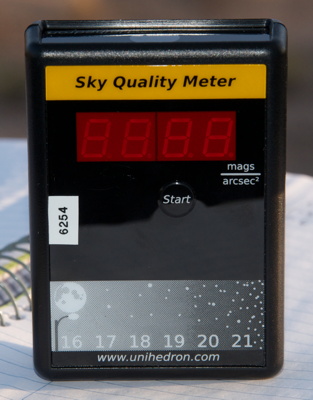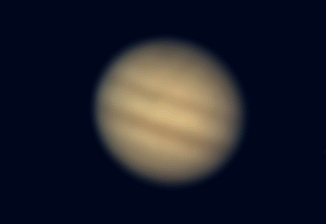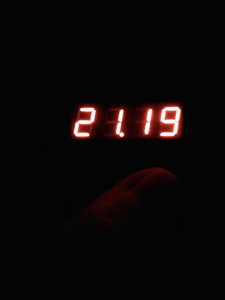
GorillaPOD, Jupiter, NightCap Pro, ISS, M49 Galaxy, Mars,
Sky Quality Measurements
Posted: 24 April 2014
|
Opened: Wednesday, 23 April 2014, 1811 MST Temperature: 84°F |
Session: 678 Conditions: Mostly clear, some clouds low in south |
My planned activities for this night included doing some more tests with the new NightCap Pro iOS app. I had done some initial tests with the app on 16 April. On Tuesday, 22 April, I received my newly purchased Joby GripTight GorillaPod Stand for my iPhone 5s. This is how it looks on the SkyShed POD dome flange:

This is how it looks attached to the SkyShed POD wall, which is a very useful location:

Another planned activity for this night was to do some Cassiopeia Observatory sky quality measurements. I picked up a loaner NOAO SQM meter from the International Dark-Sky Association on Wednesday, 23 April, to take measurements at Oracle State Park for our "International Dark Sky Park" Nomination Package. As part of the loan, I agreed to take measurements using the Dark Sky Meter iOS app for comparison to a real SQM meter. This is the real meter:

I updated the TLE in the telescope for the night's short pass of the International Space Station (ISS).
1837 MST: viewed Jupiter, 83X. One moon (Ganymede) was visible against the still very bright sky. Using 222X, seeing was fairly good at Jupiter. I began preparing for iPhone 5s imaging of Jupiter. Some clouds had appeared in the west near the soon to set sun. 1901 MST: sunset.
This is Jupiter and the moon Io with the iPhone 5s afocal 666X on the 8" LX200-ACF telescope, single photo with some digital zoom, cropped from the full-frame image:

This is a stack of 1717 slo-mo (120 fps) video frames, afocal 666X:

1911 MST: resumed Jupiter observing, 222X. All four Galilean Moons were now visible.
1923 MST: viewed Mars, 222X. It was too low in the sky for good viewing. 1935 MST: the Martian North Polar Cap was now visible. There were also what appeared to be sunrise and sunset clouds at the limb. 1957 MST: seeing at Mars still not very good.
I mounted the D7000 DSLR at prime focus + 2X PowerMate for ISS imaging. Checked the finderscope alignment and camera focus using Mars. Finderscope was OK but seeing was not good enough for reliable focusing using Mars. Slewed to the star Sirius and used the Bahtinov Mask for precise focusing. Locked the telescope focus. 2011 MST: all was ready for the ISS pass, which was to begin at 2047 MST.
While waiting for the ISS pass, I did some tests with NightCap Pro and photographed the western sky. The iPhone 5s was mounted on the POD wall using the GorillaPod. (And of course, while I was in the observatory I was listening to some classical music on my iPod. Lots of "pods" at Cassiopeia Observatory!) This image was taken at 2021 MST, Night Mode, Long Exposure (60 seconds), full Light Boost, with the focus locked:

The app saved the image as HQ JPEG. As I noted in my previous NightCap Pro report, focus is a challenge since there is no manual focus capability. I had to wait for the stars (easily seen live on the iPhone screen) to come into focus and then tap the Focus Lock without inducing any movement in the phone. The stars still look out of focus.
2027 MST: I began waiting for the ISS pass to start. 2038 MST: the Zodiacal Light was very bright. The ISS pass started on time and tracking was pretty good. Here are two images (cropped) showing the ISS, 1/1250sec, ISO 5000, with the solar panels just barely visible above and below the station core:

2058 MST: resumed Mars observing, 222X. Seeing was a little better. There were definitely some sunrise clouds visible.
2105 MST: viewed the Virgo galaxies M49, M98, M99, and M100, 83X.
2109 MST: did sky quality measurements. There were some high thin clouds around, which may have slightly affected the measurements. These were the readings (Dark Sky Meter app on the left and the SQM meter on the right):


2125 MST: resumed Mars observing, 222X. Seeing slightly better. This screen shot of the Mars Globe iOS app shows the surface features that were visible:

2134 MST: returned to M49 galaxy and mounted the D7000 DSLR at prime focus + focal reducer + off-axis guider. Did a focus test image on the star Spica using the Bahtinov Mask. Then did a framing test image of M49. Framing was good but no guide star was found. Decided to do unguided imaging. Tried exposures of 120 seconds and 90 seconds, but both showed some star trailing. Decided to do 10 1 minute ISO 6400 unguided exposures. This is a stack of 8 images (effective exposure time 8 minutes):

M49 is the large galaxy in the center. There are 7 other fainter and smaller galaxies visible in the image.
2211 MST: completed DSO imaging. Still some clouds visible in the sky. 2222 MST: returned to Mars. Decided to try iPhone imaging of Mars, afocal 666X + one of the Variable Polarizing Filters. Seeing was not very good, as was obvious since Mars was moving around a lot on the iPhone screen. This cropped single frame photograph was taken with some digital zoom:

This image is a stack of 1727 slo-mo frames, 666X + filter:

The North Polar Cap is about 2 o'clock, with some clouds at 11 o'clock and along the right side limb.
2237 MST: did some brief Mars observing, 222X. Then slewed to Saturn, low in the southeast. Viewed Saturn at 222X and 83X.
2246 MST: did more sky quality measurements. There were still high thin clouds in the sky and some stars appeared slightly fuzzy to the eye. These were the readings (Dark Sky Meter app on the left and the SQM meter on the right):


Even with the thin clouds, the SQM for Cassiopeia Observatory on this night was pretty good. This data has been provided to IDA and the app developer.
|
Closed: Wednesday, 23 April 2014, 2306 MST Temperature: 57°F |
|
Comments are welcome using Email. If you are on Twitter you can use the button below to tweet this report to your followers. Thanks.
Cassiopeia Observatory Home Page